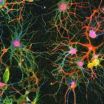(Press-News.org) A short push on the light switch – and the whole ceiling lights up in a uniform and pleasant color. This "illuminated sky" is not available as yet, but researchers from all over the world are working on it flat out. The technology behind this marvel is based on organic light-emitting diodes, or OLEDs for short. These diodes use special molecules to emit light as soon as current passes through them. Although the first OLEDs have only recently become available, they are small and expensive. A flat disk with a diameter of eight centimeters costs around Euro 250. Experts of the Fraunhofer Institute for Laser Technology ILT in Aachen, Germany are working together with Philips to develop a process for making these lamps distinctly bigger and cheaper – and thus suitable for mass market.
These new lamps are expensive primarily due to the costly manufacturing process. An OLED consists of a sandwich layer structure: a flat electrode at the bottom, several intermediate layers on top as well as the actual luminescent layer consisting of organic molecules. The final layer is a second electrode made of a special material called ITO (indium tin oxide). Together with the lower electrode, the ITO layer has the job of supplying the OLED molecules with current and causing them to light up. The problem is, however, that the ITO electrode is not conductive enough to distribute the current uniformly across a larger surface. The consequence: Instead of a homogeneous fluorescent pattern, the brightness visibly decreases in the center of the surface luminaire. "In order to compensate, additional conductor paths are attached to the ITO layer," says Christian Vedder, project manager at the Fraunhofer Institute for Laser Technology. "These conductor paths consist of metal and distribute the current uniformly across the surface so that the lamp is lit homogenously."
Normally the conductor paths are applied by energy-intensive evaporation and structuring processes, while only a maximum of ten percent of the luminous area may be covered by conductor paths. "The large remainder including the chemical etchant has to be recycled in a complicated process," explains Christian Vedder. This is different in the new process from the researchers from the Fraunhofer Institute for Laser Technology. Instead of depositing a lot of material by evaporation and removing most of it again, the scientists only apply precisely the amount of metal required. First of all they lay a mask foie on the surface of the ITO electrode. The mask has micrometer slits where later the conductive paths are supposed to be. On this mask the researchers deposit a thin film of metal made of aluminum, copper or silver – the metal the conductor path is supposed to be made of. Subsequently a laser passes over the conductor path pattern at a speed of several meters per second. The metal melts and evaporates while the vapor pressure makes sure that the melt drops are pressed through the fine slits in the masks on to the ITO electrode. The result are extremely fine conductor paths. At up to 40 micrometers, they are distinctly narrower than the 100 micrometer conductor paths which can be produced with conventional technology. "We have already been able to demonstrate that our methods works in the laboratory," says Christian Vedder. "The next step is implementing this method in industrial practice together with our partner Philips and developing a plant technology for inexpensively applying the conductor paths on a large scale." The new laser process could be ready for practical application in two to three years.
INFORMATION:
Conductor paths for marvelous light
2010-11-19
ELSE PRESS RELEASES FROM THIS DATE:
Compound that blocks sugar pathway slows cancer cell growth
2010-11-19
Scientists at Johns Hopkins have identified a compound that could be used to starve cancers of their sugar-based building blocks. The compound, called a glutaminase inhibitor, has been tested on laboratory-cultured, sugar-hungry brain cancer cells and, the scientists say, may have the potential to be used for many types of primary brain tumors.
The Johns Hopkins scientists, are inventors on patent applications related to the discovery, caution that glutaminase inhibitors have not been tested in animals or humans, but their findings may spark new interest in the glutaminase ...
Process leading to protein diversity in cells important for proper neuron firing
2010-11-19
PHILADELPHIA – Cells have their own version of the cut-and-paste editing function called splicing. Researchers at the University of Pennsylvania School of Medicine have documented a novel form of splicing in the cytoplasm of a nerve cell, which dictates a special form of a potassium channel protein in the outer membrane. The channel protein is found in the dendrites of hippocampus cells -- the seat of memory, learning, and spatial navigation -- and is involved in coordinating the electrical firing of nerve cells. Dendrites, which branch from the cell body of the neuron, ...
Does sex matter? It may when evaluating mental status
2010-11-19
Montreal, November 18, 2010 – Schizophrenia is a mental disorder that differs between the sexes in terms of age at onset, symptomatology, response to medication, and structural brain abnormalities. Now, a new study from the Université de Montréal shows that there is gender difference between men and women's mental ability – with women performing better than men. These findings, published recently in, Schizophrenia Research, have implications for the more than 300 000 affected Canadians.
"We are the first to report sex differences in brain function of schizophrenics," ...
10 years of Soufriere Hills Volcano research published
2010-11-19
The Soufriere Hills Volcano on Montserrat erupted in 1995, and an international team of researchers has studied this volcano from land and sea since then to understand the workings of andesite volcanos more completely.
"To the extent that the Soufriere Hills Volcano is typical of andesitic dome building volcanoes, results from this research can be expected to apply more generally," said Barry Voight, professor emeritus of geosciences, Penn State.
Voight and R. S. J. Sparks, the Channing Wills professor of geology, Bristol University, guest edited and introduced a special ...
E. coli infection linked to long-term health problems
2010-11-19
People who contract gastroenteritis from drinking water contaminated with E. coli are at an increased risk of developing high blood pressure, kidney problems and heart disease in later life, finds a study published on bmj.com today.
The findings underline the importance of ensuring a safe food and water supply and the need for regular monitoring for those affected.
It is estimated that E. coli O157:H7 infections cause up to 120,000 gastro-enteric illnesses annually in the US alone, resulting in over 2,000 hospitalisations and 60 deaths. However, the long term health ...
Researchers learn that genetics determine winter vitamin D status
2010-11-19
Vitamin D is somewhat of an unusual "vitamin," because it can be made in the body from sunlight and most foods do not contain vitamin D unless added by fortification. Synthesis of vitamin D in the body requires exposure to ultraviolet light and can be influenced by genetics, skin color, and sun exposure. Reports of greater than expected vitamin D insufficiency coupled with emerging evidence that higher circulating concentrations of this nutrient may protect against cardiovascular disease have prompted a renewed interest in teasing out how environment, genetics, and behavior ...
Why so many antibodies fail to protect against HIV infection
2010-11-19
DURHAM, NC – Researchers have been stymied for years over the fact that people infected with the AIDS virus do indeed produce antibodies in response to the pathogen – antibodies that turn out to be ineffective in blocking infection.
Now, scientists at Duke University Medical Center can explain why: Some of the earliest and most abundant antibodies available to fight HIV can't actually "see" the virus until after it's already invaded a healthy cell.
The scientists based their conclusion on the results of a series of crystallography and biochemical experiments that revealed ...
Economic downturn takes toll on health of Americans with heart disease, diabetes or cancer
2010-11-19
Boston, MA – A new poll from researchers at the Harvard School of Public Health (HSPH) and Knowledge Networks (KN) shows that many people with heart disease, diabetes or cancer believe the economic downturn is hurting their health and will have further negative impacts in the future. Many Americans with these illnesses face financial problems paying for medical bills in this economy. Most of these people do not believe the new national health care reform law (Patient Protection and Affordable Care Act 2010) will help them. This national poll is the first in a collaborative ...
Reduce the VAT on alcohol sold in pubs, says expert
2010-11-19
Alcoholic drinks served in pubs should be taxed at a lower level than drinks bought from shops, says an expert in this week's BMJ.
This action would deliver the health benefits associated with introducing a minimum price on alcohol, increase tax revenue for the Treasury and save pubs says Dr Nick Sheron.
The author is head of clinical hepatology at the University of Southampton, a member of the Alcohol Health Alliance and an advisor for the 2010 House of Commons Select Committee Report on Alcohol.
Sheron says lowering VAT for alcohol sold in pubs would solve the plight ...
LSUHSC reports first successful salivary stone removal with robotics
2010-11-19
New Orleans, LA – Dr. Rohan Walvekar, Assistant Professor of Otolaryngology Head and Neck Surgery, Director of Clinical Research and the Salivary Endoscopy Service at LSU Health Sciences Center New Orleans, has reported the first use of a surgical robot guided by a miniature salivary endoscope to remove a 20mm salivary stone and repair the salivary duct of a 31-year-old patient. Giant stones have traditionally required complete removal of the salivary gland. Building upon their success with the combination of salivary endoscopic guidance with surgery, Dr. Walvekar and his ...


